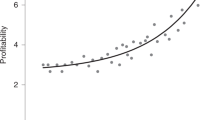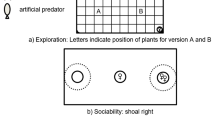Abstract
Although many studies have examined the effects of male size on attractiveness and mating behaviour, few have taken genetic background into consideration. Phenotypic manipulation permits the experimental adjustment of morphological traits while keeping genetic background constant. Here, male guppies, Poecilia reticulata, an ideal model for this type of manipulation, were raised at different temperatures to produce sibling pairs that differed in size. These were then used to investigate male mating behaviour and male attractiveness, assessed through female mate choice, in relation to this size dimorphism. Further, male–male competition, which is intrinsic to male mating behaviour, is also likely to be affected by their size. Through the use of repeated measures analyses we demonstrate that females significantly prefer larger males and male size and competition significantly affect several aspects of male mating behaviour. Larger siblings perform more sneaky mating attempts and spend more time chasing females. The frequencies of both these behaviours increase with competition. While display frequency is unaffected by male size and competition, display duration and the amount of time spent attending females are reduced in the presence of competitors. This study highlights the use of phenotypic manipulation as a valuable tool for investigating behavioural interactions and confirms that both male size and competition are significant factors in the guppy mating system.


Similar content being viewed by others
References
Andersson M (1982) Female choice selects for extreme tail length in a widowbird. Nature 299:818–820
Andersson MB (1994) Sexual selection. Princeton University Press, Princeton, NJ
Atkinson D (1994) Temperature and organism size—a biological law for ectotherms. Adv Ecol Res 25:1–58
Aubin-Horth N, Dodson JJ (2004) Influence of individual body size and variable thresholds on the incidence of a sneaker male reproductive tactic in atlantic salmon. Evolution 58:136–144
Becher SA, Magurran AE (2004) Multiple mating and reproductive skew in Trinidadian guppies. Proc R Soc London B Biol Sci 271:1009–1014
Blake RW (1983) Fish locomotion. Cambridge University Press, Cambridge
Bro-Jørgensen J (2002) Overt female mate competition and preference for central males in a lekking antelope. Proc Natl Acad Sci USA 99:9290–9293
Brockmann HJ (2002) An experimental approach to altering mating tactics in male horseshoe crabs (Limulus polyphemus). Behav Ecol 13:232–238
Candolin U (2003) The use of multiple cues in mate choice. Biol Rev 78:575–595
Censky EJ (1997) Female mate choice in the non-territorial lizard Ameiva plei (Teiidae). Behav Ecol Sociobiol 40:221–225
Croft DP, Albanese B, Arrowsmith BJ, Botham M, Webster M, Krause J (2003) Sex-biased movement in the guppy (Poecilia reticulata). Oecologia 137:62–68
Elphick MJ, Shine R (1998) Long-term effects of incubation temperatures on the morphology and locomotor performance of hatchling lizards (Bassiana duperreyi, Scincidae). Biol J Linn Soc 63:429–447
Endler JA (1995) Multiple-trait coevolution and environmental gradients in guppies. Trends Ecol Evol 10:22–29
Endler JA, Houde AE (1995) Geographic variation in female preferences for male traits in Poecilia reticulata. Evolution 49:456–468
Evans JP, Zane L, Francescato S, Pilastro A (2003) Directional postcopulatory sexual selection revealed by artificial insemination. Nature 421:360–363
Farr JA (1976) Social facilitation of male sexual-behavior, intra-sexual competition, and sexual selection in guppy, Poecilia reticulata (Pisces, Poeciliidae). Evolution 30:707–717
Farr JA, Travis J, Trexler JC (1986) Behavioral allometry and interdemic variation in sexual behavior of the sailfin molly, Poecilia latipinna (Pisces, Poeciliidae). Anim Behav 34:497–509
Fisher RA (1958) The genetical theory of natural selection. Dover, New York
Gross MR (1996) Alternative reproductive strategies and tactics: diversity within the sexes. Trends Ecol Evol 11:92–98
Hosn WA (1999) Quantitative analysis and modelling of the behavioural dynamics of Salvelinus fontinalis (brook trout). Behav Proc 46:105–120
Houde AE (1997) Sex, color, and mate choice in guppies. Princeton University Press, Princeton, NJ
Houde AE, Endler JA (1990) Correlated evolution of female mating preferences and male color patterns in the guppy, Poecilia reticulata. Science 248:1405–1408
Huey RB, Berrigan D (1996) Testing evolutionary hypotheses of acclimation. In: Johnston IA, Bennett AF (eds) Animals and temperature: phenotypic and evolutionary adaptation. Cambridge University Press, Cambridge, UK, pp 205–237
Hughes AL (1985) Male size, mating success, and mating strategy in the mosquitofish Gambusia affinis (Poeciliidae). Behav Ecol Sociobiol 17:271–278
Iyengar VK, Reeve HK, Eisner T (2002) Paternal inheritance of a female moth’s mating preference. Nature 419:830–832
Jennions MD, Moller AP, Petrie M (2001) Sexually selected traits and adult survival: A meta-analysis. Q Rev Biol 76:3–36
Jennions MD, Petrie M (1997) Variation in mate choice and mating preferences: A review of causes and consequences. Biol Rev 72:283–327
Jirotkul M (1999) Operational sex ratio influences female preference and male–male competition in guppies. Anim Behav 58:287–294
Johnston IA (2001) Genetic and environmental determinants of muscle growth patterns. In: Johnston IA (ed) Muscle development and growth. Academic Press, San Diego, pp 141–186
Karino K, Matsunaga J (2002) Female mate preference is for male total length, not tail length in feral guppies. Behaviour 139:1491–1508
Kelley JL, Graves JA, Magurran AE (1999) Familiarity breeds contempt in guppies. Nature 401:661–662
Ketterson ED, Nolan V (1999) Adaptation, exaptation, and constraint: A hormonal perspective. Am Nat 154:S4–S25
Liley NR (1966) Ethological isolating mechanisms in four sympatric species of poeciliid fishes. Behaviour, Suppl 13:1–197
Liley NR, Seghers BH (1975) Factors affecting the morphology and behaviour of guppies in Trinidad. In: Baerends G, Beer C, Manning A (eds) Function and evolution in behaviour. Clarendon Press, Oxford, pp 92–118
Littell RC, Milliken GA, Stroup WW, Wolfinger RD (1996) SAS system for mixed models. SAS Institute, Cary, NC
Lynch M, Walsh B (1998) Genetics and analysis of quantitative traits. Sinauer Associates Inc., Sunderland, MA
Magurran AE (1998) Population differentiation without speciation. Philos T Roy Soc B 353:275–286
Magurran AE (2001) Sexual conflict and evolution in Trinidadian guppies. Genetica 112–113:463–474
Magurran AE, Phillip DAT (2001) Evolutionary implications of large-scale patterns in the ecology of Trinidadian guppies, Poecilia reticulata. Biol J Linn Soc 73:1–9
Moczek AP, Emlen DJ (2000) Male horn dimorphism in the scarab beetle, Onthophagus taurus: do alternative reproductive tactics favour alternative phenotypes? Anim Behav 59:459–466
Møller AP, Alatalo RV (1999) Good-genes effects in sexual selection. Proc R Soc London B Biol Sci 266:85–91
Nicoletto PF (1993) Female sexual response to condition-dependent ornaments in the guppy, Poecilia reticulata. Anim Behav 46:441–450
O’Steen S, Bennett AF (2003) Thermal acclimation effects differ between voluntary, maximum, and critical swimming velocities in two cyprinid fishes. Physiol Biochem Zool 76:484–496
Olsson M, Madsen T (1998) Sexual selection and sperm competition in reptiles. In: Birkhead TR, Møller AP (eds) Sexual selection and sperm competition. Academic Press, London, pp 503–564
Pettersson LB, Brönmark C (1999) Energetic consequences of an inducible morphological defence in crucian carp. Oecologia 121:12–18
Pettersson LB, Ramnarine IW, Becher SA, Mahabir R, Magurran AE (2004) Sex ratio dynamics and fluctuating selection pressures in natural populations of the Trinidadian guppy, Poecilia reticulata. Behav Ecol Sociobiol 55:461–468
Quinn TP, Foote CJ (1994) The effects of body size and sexual dimorphism on the reproductive behaviour of sockeye salmon, Oncorhynchus nerka. Anim Behav 48:751–761
Reynolds JD, Gross MR (1992) Female mate preference enhances offspring growth and reproduction in a fish, Poecilia reticulata. Proc R Soc London B Biol Sci 250:57–62
Reznick D, Butler MJ, Rodd H (2001) Life-history evolution in guppies. VII. The comparative ecology of high- and low-predation environments. Am Nat 157:126–140
Reznick DN, Butler MJ IV, Rodd FH, Ross P (1996) Life-history evolution in guppies (Poecilia reticulata: Poeciliidae). 6. Differential mortality as a mechanism for natural selection. Evolution 50:1651–1660
Rodd FH, Reznick DN, Sokolowski MB (1997) Phenotypic plasticity in the life history traits of guppies: Responses to social environment. Ecology 78:419–433
Rodd FH, Sokolowski MB (1995) Complex origins of variation in the sexual behavior of male Trinidadian guppies, Poecilia reticulata : Interactions between social environment, heredity, body size and age. Anim Behav 49:1139–1159
Rose MR, Nusbaum TJ, Chippindale AK (1996) Laboratory selection: The experimental wonderland and the Cheshire cat syndrome. In: Rose MR, Lauder GV (eds) Adaptation. Academic Press, San Diego, CA, pp 221–242
Ryan MJ (1994) Mechanistic studies in sexual selection. In: Real LA (ed) Behavioral mechanisms in evolutionary ecology. University of Chicago Press, Chicago, IL, pp 190–215
Ryan MJ, Causey BA (1989) Alternative mating behavior in the swordtails Xiphophorus nigrensis and Xiphophorus pygmaeus (Pisces, Poeciliidae). Behav Ecol Sociobiol 24:341–348
SAS Institute (1999) SAS version 8.2. SAS Institute Inc., Cary, NC
Scheiner SM (2001) MANOVA: Multiple response variables and multispecies interactions. In: Scheiner SM, Gurevitch J (eds) Design and analysis of ecological experiments. Chapman & Hall, New York, pp 99–115
Schmitt J, Dudley SA, Pigliucci M (1999) Manipulative approaches to testing adaptive plasticity: Phytochrome-mediated shade-avoidance responses in plants. Am Nat 154:S43–S54
Shine R, Langkilde T, Mason RT (2003) The opportunistic serpent: male garter snakes adjust courtship tactics to mating opportunities. Behaviour 140:1509–1526
Sinervo B, Basolo AL (1996) Testing adaptation using phenotypic manipulation. In: Rose MR, Lauder GV (eds) Adaptation. Academic Press, San Diego, CA, pp 149–185
Sinervo B, Huey RB (1990) Allometric engineering: an experimental test of the causes of interpopulational differences in performance. Science 248:1106–1109
Sinervo B, Svensson E (1998) Mechanistic and selective causes of life history trade-offs and plasticity. Oikos 83:432–442
Stearns SC, Kawecki TJ (1994) Fitness sensitivity and the canalization of life-history traits. Evolution 48:1438–1450
Stevens J (2002) Applied multivariate statistics for the social sciences. Lawrence Erlbaum Associates, Mahwah, NJ
Takahashi H (1975) Process of functional sex reversal of the gonad in the female guppy, Poecilia reticulata, treated with androgen before birth. Dev Growth Differ 17:167–175
Travis J, Woodward BD (1989) Social context and courtship flexibility in male sailfin mollies, Poecilia latipinna (Pisces, Poeciliidae). Anim Behav 38:1001–1011
Veggetti A, Mascarello F, Scapolo PA, Rowlerson A, Candia Carnevali MD (1993) Muscle growth and myosin isoform transitions during development of a small teleost fish, Poecilia reticulata (Peters) (Atheriniformes, Poeciliidae): a histochemical, immunochemical, ultrastructural and morphometric study. Anat Embryol (Berl) 187:353–361
Wagner WE (1998) Measuring female mating preferences. Anim Behav 55:1029–1042
West-Eberhard MJ (2003) Developmental plasticity and evolution. Oxford University Press, Oxford
Zar JH (1999) Biostatistical analysis, 4th edn. Prentice-Hall International, London UK, pp 527–530
Acknowledgements
We thank Alfredo F Ojanguren, Anna M Ludlow and three anonymous referees for valuable comments on this manuscript and Per-Erik Isberg and Henrik G Smith for statistical advice. This study was supported by the Janet Thompson Anderson Scholarship, University of St Andrews (KM), Hellmuth Hertz’ Foundation (LBP), The Swedish Foundation for International Cooperation in Research and Higher Education (LBP) and the Natural Environment Research Council UK (AEM)
Author information
Authors and Affiliations
Corresponding author
Additional information
Communicated by M. Abrahams
Rights and permissions
About this article
Cite this article
Magellan, K., Pettersson, L.B. & Magurran, A.E. Quantifying male attractiveness and mating behaviour through phenotypic size manipulation in the Trinidadian guppy, Poecilia reticulata. Behav Ecol Sociobiol 58, 366–374 (2005). https://doi.org/10.1007/s00265-005-0950-6
Received:
Revised:
Accepted:
Published:
Issue Date:
DOI: https://doi.org/10.1007/s00265-005-0950-6




